Larissa Maxwell
Where do you live: Vancouver, British Columbia, Canada
Your education: Bachelor of Arts, Masters of Business Administration, Current Phd Student
Describe your art in three words: dimensional, pioneering, purposeful
Your discipline: acrylic and encaustic fine art, immersive storytelling
Website | Instagram
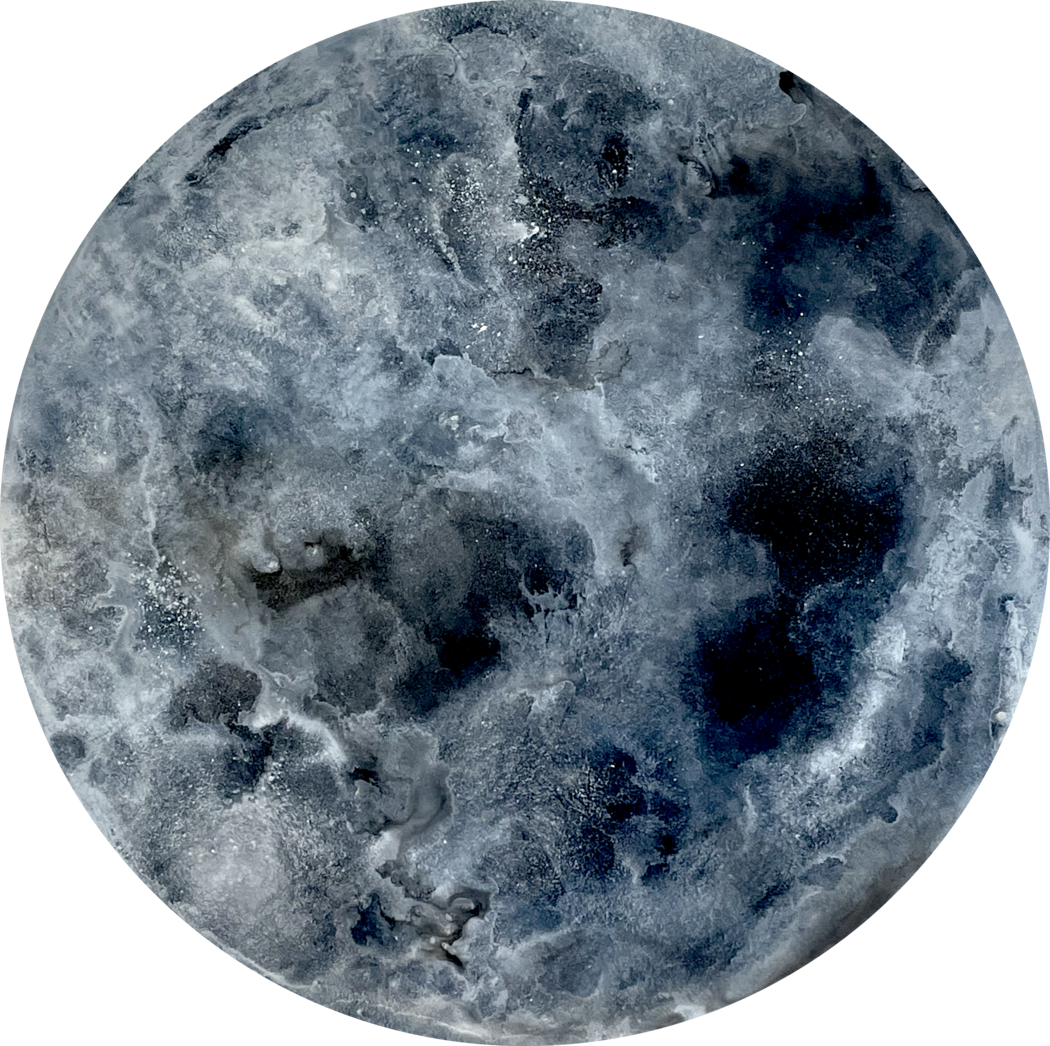 Larissa Maxwell, Solitudine, 2023
Larissa Maxwell, Solitudine, 2023
What inspired you to create the “Worlds Apart, World’s Together” collection, and how did the pandemic shape its themes?
In late 2022 and early 2023, the world began to navigate life post-COVID. We all hoped for an end, but instead, we had to adapt to a “new normal” that felt anything but familiar. As we bounced between health orders, I observed significant shifts in the communities around me—people had changed. Our social skills, environmental awareness, relationship with work and pets, finances, and news intake were all evolving. Yet, in our rush to return to normal, I felt we hadn’t fully processed these changes and losses. This show was created as an immersive experience to help communities reflect on and heal from the pandemic’s impact—acknowledging, grieving, appreciating, and confronting what had shifted. Each theme was inspired by my personal journey and designed to resonate with viewers, encouraging them to find their own reference point. Hosted in a high-traffic public space in partnership with a prominent property developer, the exhibition was intentionally placed in a setting where, despite affluence and influence, we might not expect to see signs of struggle or suffering.
Can you tell us about your creative process?
I tend to create in cycles of flow and restlenessness. For months at a time, I feel a surge of creative energy, allowing me to produce whole collections with utter abandonment and freedom. During this phase, I find it essential to avoid the work of other artists, as I can be quite porous and risk engaging in mimicry, and need to focus on my own unique voice and process. However, when I least expect it, the flow state stops, and I shift into complete restlessness. The energy feels off, and my work begins to feel forced; I find myself roaming my house, frustrated and fidgety. This is the ideal time for me to step back, absorb the creative work of others, pick up art forms I don’t engage in professionally (such as block printing), and rest. It’s in these periods I wrestle through and refine my storytelling and conceptual frameworks for collections. I’ve learned to appreciate this part of my creative process and no longer fight it, but instead embrace it.
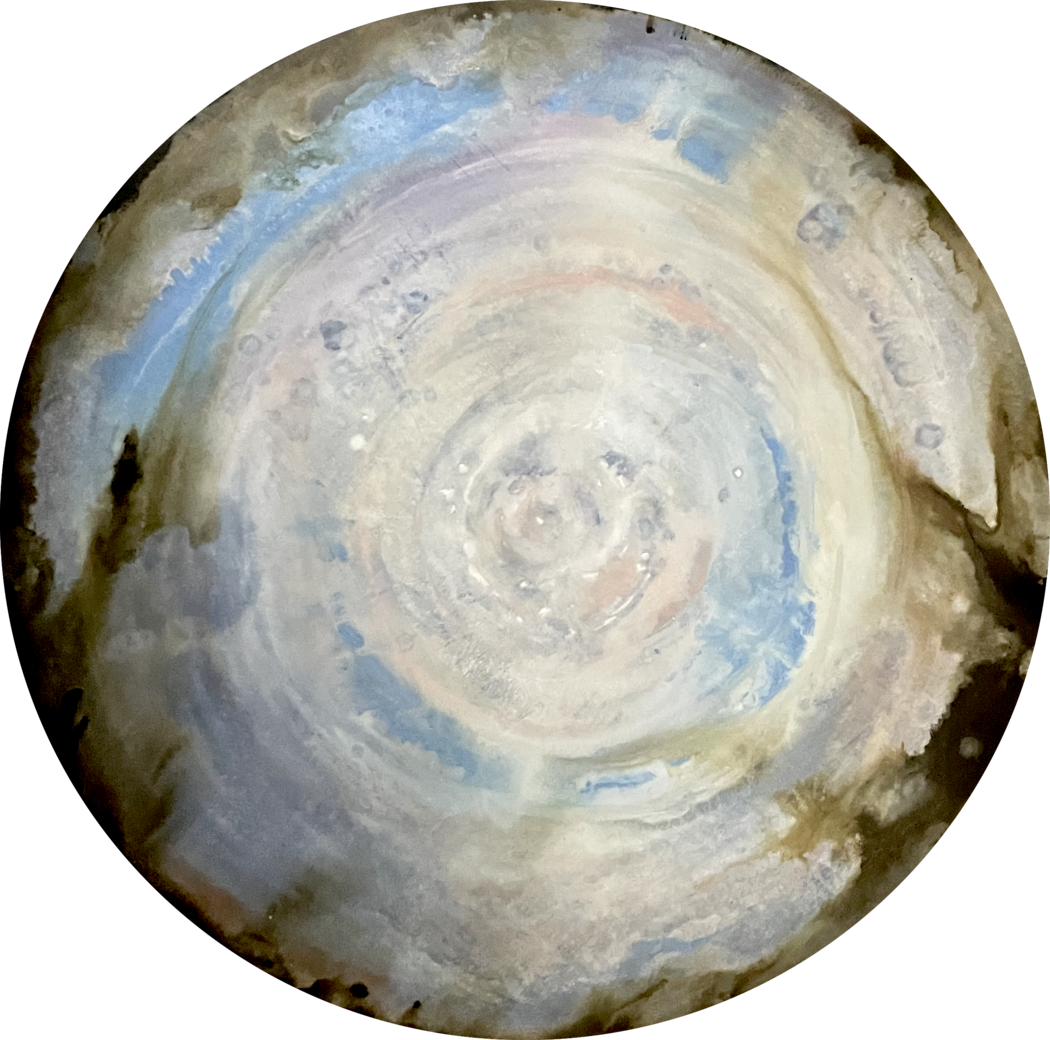 Larissa Maxwell, Nascita, 2023
Larissa Maxwell, Nascita, 2023
How do you decide on materials like mica, liquid mirror, and shellac burns?
My work is a vivid and joyful exploration of materials that has been honed over time and requires a friendship with the unpredictable. Acrylic, in particular, is a medium with unique and sometimes volatile reactions to air, temperature, water, salt, and mica. It’s a challenge to harness and direct these reactions, while also submitting to them when they occur, and I’ve spent years in exploration. My roots are in watercolor, and I bring those skills into my acrylic work. Over the last seven years, I’ve also started to explore encaustic as a medium, expanding my creative range to include heated beesewax, demar resin, pigment, and shellac.
In “Tra Questo Mondo e L’altro,” (Italian for In Between This World and the Next) you reflect on the lives lost during the pandemic. How do you personally cope with loss, and what role does art play in that journey?
In December 2022, we lost our family matriarch, my Nonna, Iolanda Violini. She was the central figure in my life, the one we called “grand central station,” as she kept us all together and knew everything about everyone. By a measure of grace, her care home allowed us to spend her last days with her in person. Unlike many others, this loss was expected, and we had the conversations we wanted to have. However, a celebration of her life wasn’t possible, and we were told that, due to the many losses, they were having difficulty locating her ashes at the crematorium.
She had gifted me my first art studio in her house, and after she passed, I was reminded of how she used to watch me paint, often for hours. She would be so quiet I would forget she was there until I would hear, “brava Larissa!”. As I prepared for this show and spent countless hours in the studio, I found myself talking to her often. I hoped she would visit me and even humourously invited her to haunt me. She never did, but I had this feeling that she hadn’t truly “left.” It felt like she was still in a space between this world and the next, much like many others who had lost someone and never had a formal ritual to celebrate that loss together. This piece reflects that experience and creates space for the viewer to process and let go of loved ones.
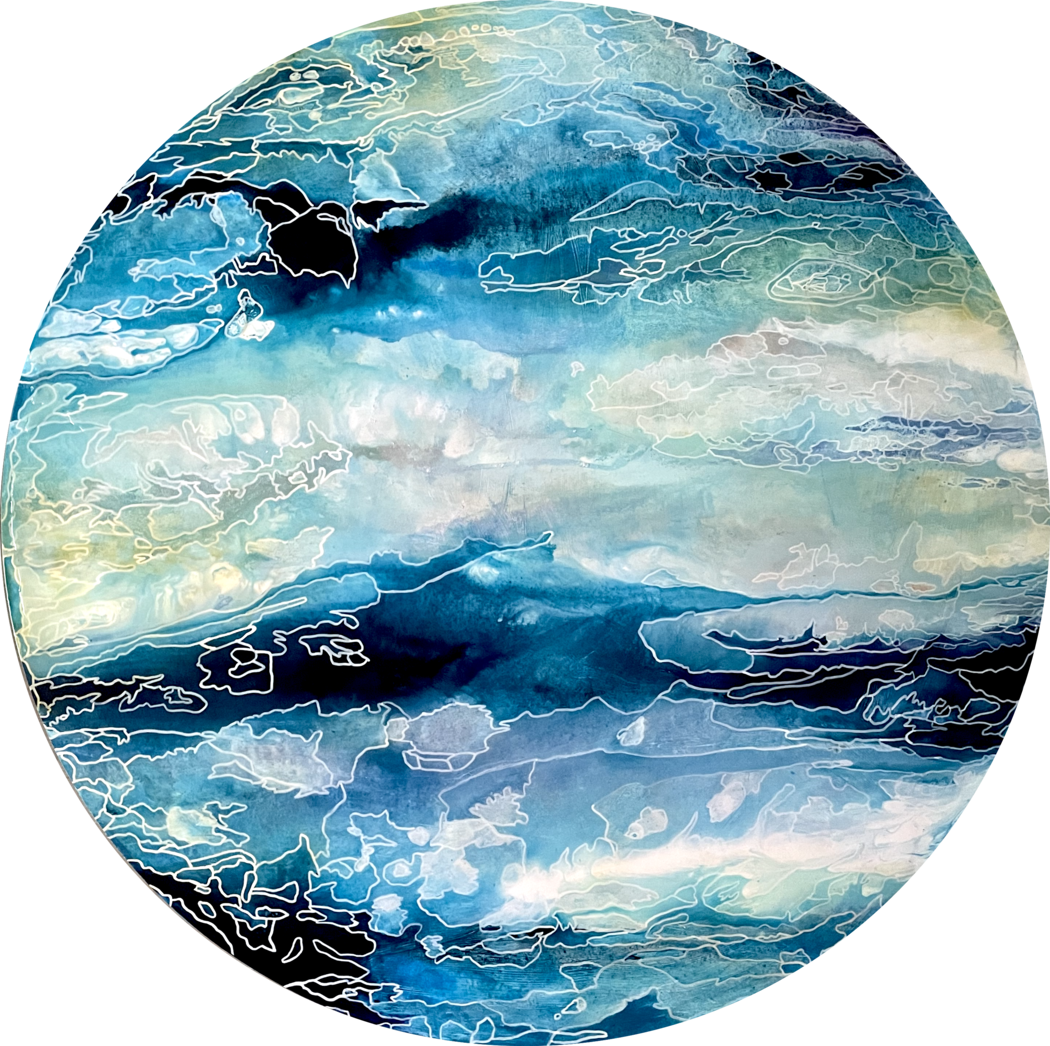 Larissa Maxwell, Guarire Insieme, 2023
Larissa Maxwell, Guarire Insieme, 2023
In “Future of Work,” you address the transformation of work post-pandemic. How has your own work routine changed, and what lessons do you think artists can take from this shift?
In the past few years, I’ve integrated a more flexible schedule for myself—for example, it’s okay to work on weekends, just not work both all week and weekends—and embraced AI as a helpful editor for my written work.
Some of us embrace change, while others fear it. But change is the only constant, and it’s how we stay mentally young and agile. I encourage artists not to fear the future—we are the future. We bring a creative language the world needs to hear and, through the centuries and countless changes, not only survived but thrived. Let’s not underestimate what we have to offer in a changing world, and remember, the world needs us to contribute what only uniquely we can.
“Fiducia Istituzionale” raises questions about institutional trust. How do you believe art can contribute to restoring or questioning trust in society?
Historically, art has played a powerful role in shaping, questionining, and opening up dialogue in society, and I think today is no different. We creatives speak unique languages that can traverse topics in a visceral and meaningful way that brings a lot of value to society. I think it’s our duty as creatives to use our voice to support our communities to engage in the world. Let our work open up hearts, expand minds, bring folks together, challenge power, and refine our collective character.
My piece Fiducia Instituzionale reflects on the pandemic and our shifting relationships with institutions, grounded in Dr. Jennifer Freyd’s work on institutional trust, betrayal, and courage. Institutional trust refers to the confidence we place in the integrity, reliability, and effectiveness of organizations such as government, education, healthcare, businesses, and non-profits. Throughout the pandemic, in both my own life and the communities I belong to, the foundation of trust in these institutions was severely shaken.
The communication and actions taken by institutions during the global health crisis were often confusing, constantly evolving, and at times based on incomplete information, all amid an atmosphere of fear. For many who trusted these institutions, questions arose about their competence and whether they could be relied upon. For others, the pandemic intensified feelings of uncertainty and disillusionment, revealing deep doubts about the ability of these institutions to guide us through the crisis. In some cases, these challenges divided families, professions, and entire communities. In retrospect, we understand that institutional responses were shaped by evolving data, leading to mixed outcomes.
As survivors, we emerged from the pandemic together, but now face the challenge of navigating fractured relationships with the institutions that shaped our experience. My work asks: How has our perception of institutional trust changed post-pandemic? Can trust in institutions that have eroded be restored? What will it take to regain our confidence? In a time when trust has been deeply tested, my work seeks to provide a space for introspection, healing, and the reimagining of a future built on renewed institutional trust.
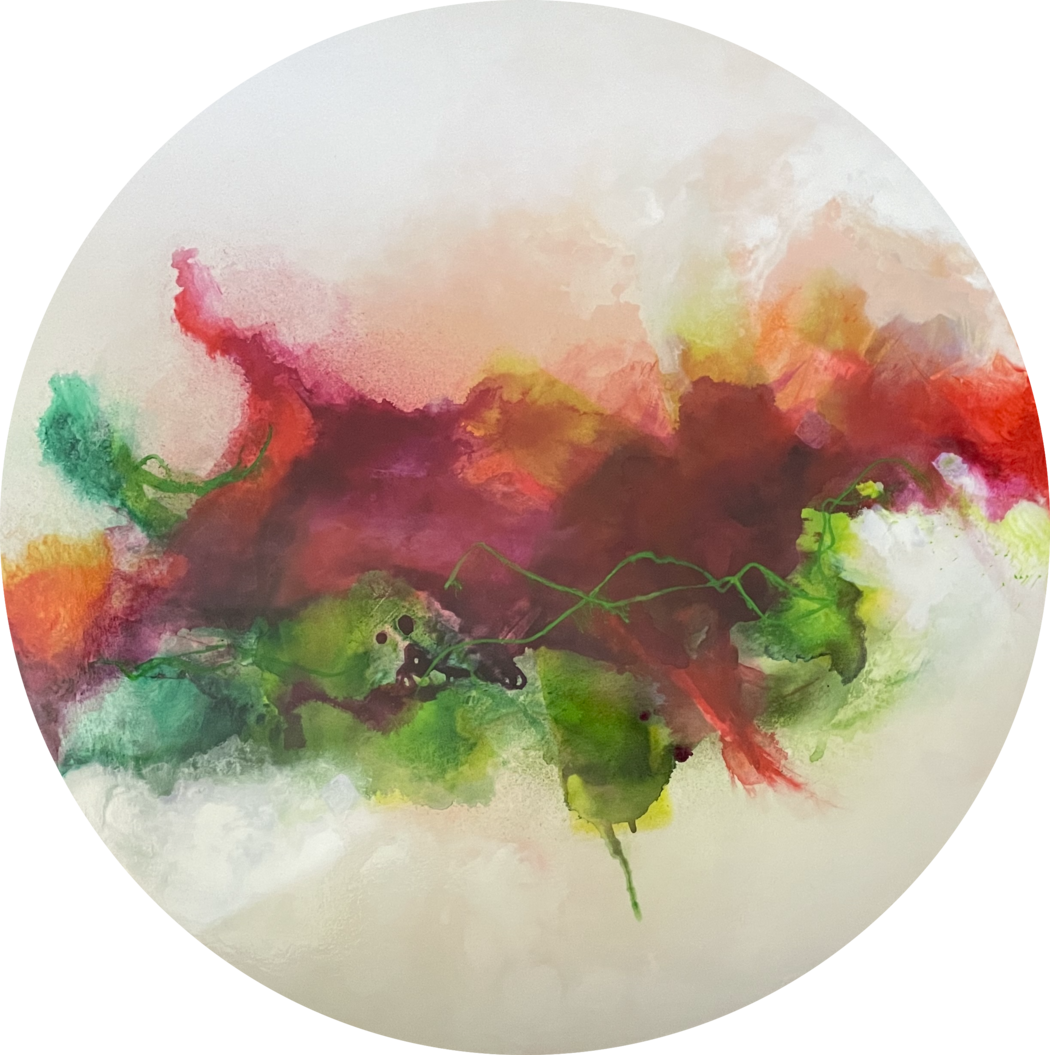 Larissa Maxwell, Futuro del Lavoro, 2023
Larissa Maxwell, Futuro del Lavoro, 2023
You have a unique combination of Italian and Scottish and Irish heritage. How do these cultural influences appear in your art, if at all?
I believe my emotional fortitude, passion, and intensity stem from both sides of my ancestry. I was primarily raised by my Italian family, and I have integrated Italian values such as vibrancy, “la dolce vita,” generosity, and reciprocity into both my work and life. While I am not yet fluent, I’ve been growing my Italian language skills and, a few years ago, decided to name all my pieces in Italian as a way to keep the language alive.
In recent years, I’ve connected more with my Irish and Scottish heritage, and in 2023, I had the opportunity to travel to Ireland to learn and work with with some of the world’s most prolific encaustic artists. This trip was incredibly powerful, as we engaged with land-based practices and materials. The insights I gained from this time have inspired a new collection for 2024, titled Amore de la Terra, a series of 2D encaustic landscapes currently in a public exhibition in Vancouver, BC, Canada over the fall of 2024.
You are completing a Phd at the University of British Columbia on Ethical Storytelling. Do you consider yourself a storyteller through your work?
Early in my career, I resisted storytelling. While there was always a story or process behind my work, I found it oddly exploitative when people asked for it. They wanted a piece of me I wasn’t ready to give. This came up particularly with a piece I created about women in leadership within patriarchal structures. It was deeply personal, but I didn’t want to repeatedly share my experiences with misogyny that informed the piece. I just wanted the title, Rise Up, to stand on its own. But viewers and collectors told me they didn’t understand it. This feeling touches on larger themes of why I study ethical storytelling—who gets to tell a story? How do we share trauma-informed, truthful stories grounded in lived experiences? What does consent in storytelling look like, especially when a story escapes your control?
In 2021, something shifted. I produced a collection called Over My Shoulder, reflecting on my relationship with those who view my work from over my shoulder. Acknowledging that interaction was surprisingly freeing, and I became more intentional with what I shared. I created an audio tour with stories, experiences, and family history that viewers could listen to as they explored the show. It was on my terms, and the impact was profound—viewers were deeply moved, some even to tears. This marked my first experience with intentional, consensual storytelling, where I chose to give the story, rather than feeling forced to share it. My agency and voice had shifted.
In 2023, my Worlds Apart, Worlds Together exhibition reached its largest audience, and I wanted to create a unified story experience. I didn’t want people to just look at art for a few minutes and leave. I wanted them to linger, to engage, and to connect with the pieces and their own lives. I developed another audio tour, which was listened to over 3,000 times. I was overjoyed reading emails and notes from people who shared their responses and stories with me. I now see my work as a branch of my personal storytelling and feel empowered to expand these curated experiences in the future.
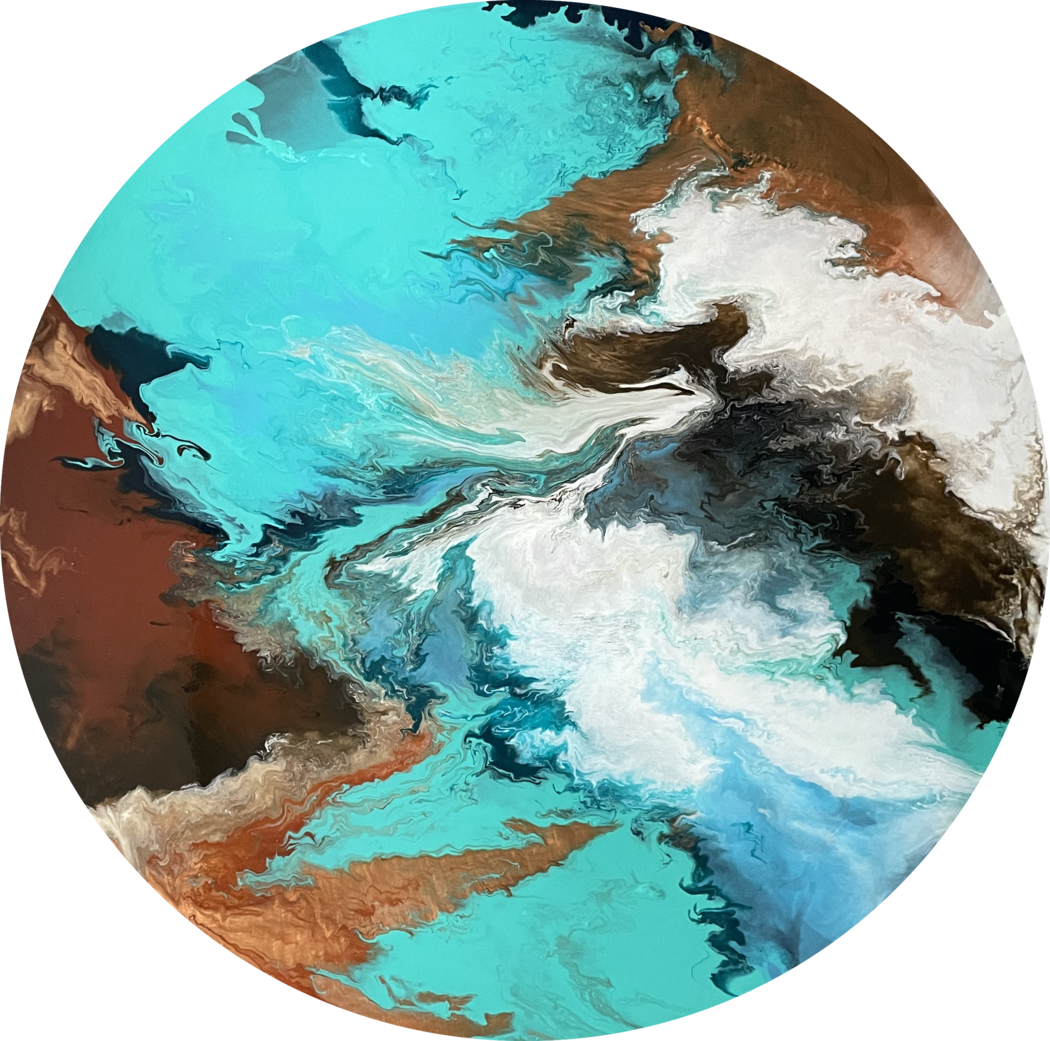 Larissa Maxwell, Tra Questo Mondo e L’altro, 2023
Larissa Maxwell, Tra Questo Mondo e L’altro, 2023

Leave a Reply